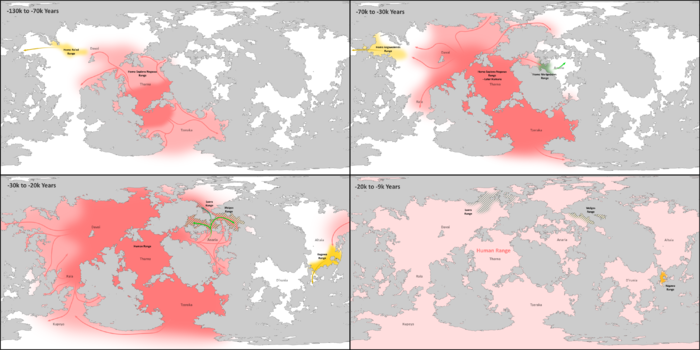History
This is a general overview of history on Gotha.
Human Ancestor Hominin Origins

Humans and the Wolgosid Hominins trace their lineage to Homo Sapiens Negasi, a Hominid that shares much of their physiology and intellectual capacity with modern humans. Homo Negasi arose in the Negasi highlands and shared southern Tharna by the year -300,000 BCE with Homo Ra'ed. Homo Ra'ed shared a common ancestor with Homo Negasi, from who they diverged half a million years ago; the ancestor is now known as Homo Prehensor. Homo Negasi is, in fact, Homo Sapiens Sapiens, and the distinction is used to refer to Humans before the Wolgosids diverged from their common lineage.
Homo Negasi was a highly successful Hominin that competed and pushed Homo Ra'ed from their range, leading to the exile of Homo Ra'ed towards Davai and eventually into Altaia as Homo Negasi and later Humans expanded across the globe. Homo Ra'ed is the direct ancestor of the modern Homo Kegawaiensis.
By the year -150,000 Homo Negasi had colonised most of southern Tharna and Northern Tzeraka and was already branching beyond their extended range by following the coasts and fertile lands of the continents.
Early Hominin Migration

Tepidus and Dual Shocks Era
Distal Ice Age Late Period
Pre-Calidus
The Pre-Calidus Era lasted around four thousand years, beginning the centuries around 16,000 years ago. An era where the climate around Gotha experienced little climatic variability due to lower Tyreal cycle celestial interactions. The climate around Gotha, despite being cooler than today's, was hospitable to the development of culture, and most of Gotha hosted biomes with bountiful resources for hominid cultures.
Most cultures moved away from rough, uncrafted stone tools and sticks to highly ingenious chipped and sanded stoned tools, utilising polishing techniques and plant resins to create composite materials and artefacts such as stone-tipped spears and arrows. The advent of twine, rope and weaving led to more dynamic cultures and tools that enabled a much greater number of hominids to survive.
Art and tools flourished. Sun-dried pottery, cave paintings, stone and wood carvings displaying a large and wide range of motifs were created across the globe. Art that depicts increasingly complex cultures and belief systems such as mythologies and creation myths, culture preserved through oral tradition and other performance arts as writing had yet to be developed.
Some mysterious possible constructs and possible artefacts from this era point to maybe civilisation dating to this era. But to date, most of these signs lack definitive evidence to suggest with certainty the existence of long-lost civilisations.
Primordial Civilization Era
The primordial civilization era is called as such as historians consider this era the cradle of true civilization on Gotha, with civilizations flourishing across four contemporary clusters separated by continent wide distances and oceans. These clusters developed once the Calidus stress has began to subside and lands with stable climate and bountiful resources became available to cultures once suspended in a survival lifestyle during the Calidus stress.
The civilization clusters are referred to as continuums as they all grew from the establishment of a primary and progenitor culture that influenced the development of other civilizations that came to be members of the continuum. A single culture would adapt to its environment, harness agriculture and grow much larger than its neolithic predecessors, founding a mythological, ideological and artistic strain, this founding culture would become the nexus of a new cultural and civilization continuum that would then promote the development of related and rival civilizations within the geographical proximity.
Ovestan Continuum
The Ovestan continuum gets its name for its dependence on the Ovestan Ocean currents and trade winds for its expansion as far as northern Tharna and Anaria Minor. The primordial founding civilisation were the Sinan that once inhabited the Simal straight archipelago. A sea faring civilization that grew from coastal cultures in these tropical islands, islands that gave these cultures a sheltered and stable landscape with bountiful shallow seas and gentle highlands amenable to garden horticulturalist.
The Sinan Civilization connected its numerous islands through a network of ports cut directly inyo the coral and volcanic rocks of its coasts, using ingenious raft boats powered by sails to transverse the shallow seas of the archipelagos and travel far across the Ovestan by following its coastal currents and winds.
The Sinan outposts in far coasts led to the spread of their culture, these trade posts and colonies seeded the formation of the Aladian, Melake, Anat, Mystrion, Cadrai, Saituka and Izaldu civilization. The Izaldu becoming one of the Sinan staunchest rivals, as they struggled over influence of the Mrekullis coast.
The continuum is renowned for promoting a religious ideology of a pantheon of gods that govern every aspect of life from a realm or overworld detached from the mortal sphere, all civilizations seeded by the Sinan Culture have a pantheon of very similar gods. The god Mirraq, the god of the blue depths, the ocean, is present in many different iterations across the continuum, sometimes the god of the ocean and in other instances the god of the void or sky. The Pantheon of the Sinan directly influenced the much latter developed Sadarisnist pantheon and mythology.
Colour Continuum
Phasian Continuum
Julian Continuum
Acha Isolate
Proximal Ice Age
Classical Era Ancient
- Huilcasonco (6492-7413 RH)
- Ilhuiyoco (7538-7465 RH)